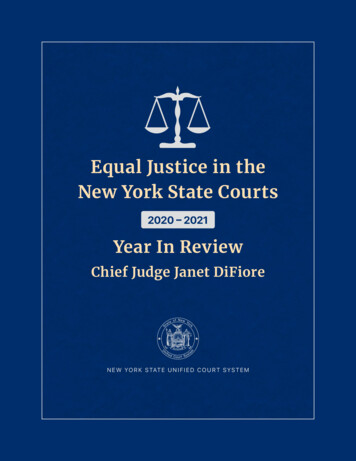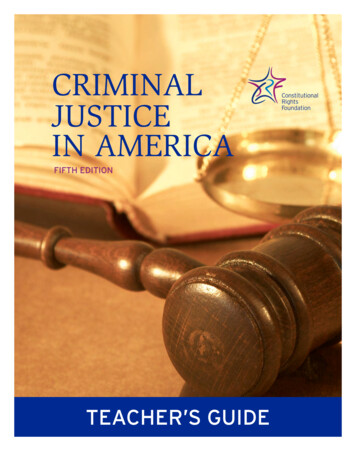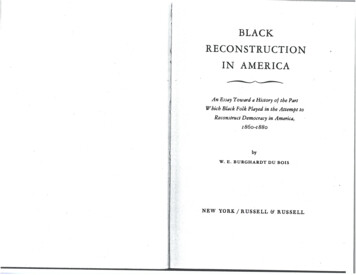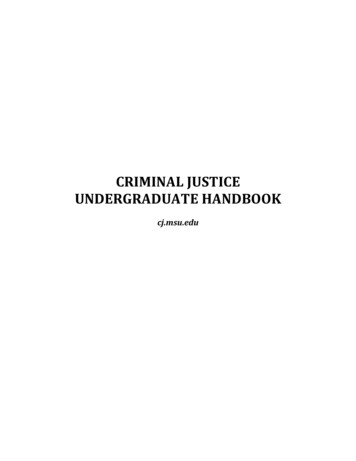
Transcription
eji.orgRECONSTRUCTION IN AMERICA122 Commerce StreetMontgomery, Alabama 36104334.269.1803RECONSTRUCTIONIN AMERICARacial Violence after the Civil War, 1865-1876 2020 by Equal Justice Initiative. All rights reserved. No part of this publication may bereproduced, modified, or distributed in any form or by any electronic or mechanicalmeans without express prior written permission of Equal Justice Initiative.
RECONSTRUCTIONIN AMERICARacial Violence after the Civil War, 1865-1876The Memorial at the EJI Legacy Pavilion in Montgomery, Alabama. (Mickey Welsh/Montgomery Advertiser)
5CONTENTSINTRODUCTION6THE DANGER OF FREEDOM56Political ViolenceAccusations of CrimeEmancipation by Proclamation—Then by Law1114Arbitrary and Random Violence586368737678FREEDOM TO FEAR22RECONSTRUCTION’S END82Reconstruction vs. Southern RedemptionJOURNEY TO FREEDOM8Emancipation and CitizenshipEconomic IntimidationEnforcing the Racial Social OrderOrganized Terror and Community MassacresInequality After EnslavementA Terrifying and Deadly BacklashBlack Political Mobilization and White BacklashFighting for EducationResisting Economic ExploitationDOCUMENTING RECONSTRUCTIONVIOLENCE283234Judicial and Political AbandonmentA Vanishing Hope8486899342A TRUTH THAT NEEDS TELLING96Notes106119Known and Unknown Horrors34 Documented Mass Lynchings During the Reconstruction EraRacial Terror and Reconstruction: A State Snapshot4852Redemption WinsAcknowledgments
7INTRODUCTIONIn 1865, after two and a half centuries of brutalenslavement, Black Americans had great hopethat emancipation would finally mean real freedom and opportunity. Most formerly enslavedpeople in the United States were remarkablywilling to live peacefully with those who hadheld them in bondage despite the violence theyhad suffered and the degradation they had endured.Emancipated Black people put aside their enslavement and embraced education, hard work,faith, and citizenship with extraordinary enthusiasm and devotion. By 1868, over 80 percentof Black men who were eligible to vote had registered, schools for Black children became apriority, and courageous Black leaders overcame enormous obstacles to win elections topublic office.The new era of Reconstruction offered greatpromise and could have radically changed thehistory of this country. However, it quickly became clear that emancipation in the UnitedStates did not mean equality for Black people.The commitment to abolish chattel slavery wasnot accompanied by a commitment to equalrights or equal protection for African Americans and the hope of Reconstruction quicklybecame a nightmare of unparalleled violenceand oppression.Between 1865 and 1876, thousands of Blackwomen, men, and children were killed, attacked, sexually assaulted, and terrorized bywhite mobs and individuals who were shieldedfrom arrest and prosecution. White perpetrators of lawless, random violence against formerly enslaved people were almost never heldaccountable—instead, they frequently were celebrated. Emboldened Confederate veteransand former enslavers organized a reign of terrorthat effectively nullified constitutional amendments designed to provide Black people equalprotection and the right to vote.In a series of devastating decisions, the UnitedStates Supreme Court blocked Congressionalefforts to protect formerly enslaved people. Indecision after decision, the Court ceded controlto the same white Southerners who used terrorand violence to stop Black political participation, upheld laws and practices codifying racialhierarchy, and embraced a new constitutionalorder defined by “states’ rights.”Within a decade after the Civil War, Congressbegan to abandon the promise of assistance tomillions of formerly enslaved Black people. Violence, mass lynchings, and lawlessness enabled white Southerners to create a regime ofwhite supremacy and Black disenfranchisement alongside a new economic order thatcontinued to exploit Black labor. White officialsin the North and West similarly rejected racialequality, codified racial discrimination, and occasionally embraced the same tactics of violentracial control seen in the South.It was during Reconstruction that acentury-long era of racial hierarchy,lynching, white supremacy, and bigotry was established—an era fromwhich this nation has yet to recover.Most Americans know very little about the Reconstruction era and its legacy. Historians havefrequently overlooked this critical 12-year period that has had profound impact on life in theUnited States. Our collective ignorance of whathappened immediately after the Civil War hascontributed to misinformed stereotypes andmisguided false narratives about who is honorable and who is not and has allowed bigotryand a legacy of racial injustice to persist.In 2015, the Equal Justice Initiative issued anew report that detailed over 4,400 documented racial terror lynchings of Black peoplein America between 1877 and 1950.We now report that during the 12year period of Reconstruction atleast 2,000 Black women, men, andchildren were victims of racial terror lynchings.Thousands more were assaulted, raped, or injured in racial terror attacks between 1865 and1876. The rate of documented racial terrorlynchings during Reconstruction is nearly threetimes greater than during the era we reportedon in 2015. Dozens of mass lynchings tookplace during Reconstruction in communitiesacross the country in which hundreds of Blackpeople were killed.Tragically, the rate of unknown lynchings ofBlack people during Reconstruction is also almost certainly dramatically higher than thethousands of unknown lynchings that tookplace between 1877 and 1950 for which nodocumentation can be found. The retaliatorykillings of Black people by white Southernersimmediately following the Civil War alone likelynumber in the thousands.EJI presents this report to provide context andanalysis of what happened during this tragicperiod of American history and to descibe itsimplications for the issues we face today. Webelieve our nation has failed to adequately address or acknowledge our history of racial injustice and that we must commit to a new eraof truth-telling followed by meaningful effortsto repair and remedy the continuing legacy ofracial oppression. We hope this report sparksmuch needed conversation and encouragescommunities to join us in the important task ofadvancing truth and justice.Bryan Stevenson, Director
9I don’t believe in the colored race beingslaves ‘cause of their color, but the wardidn’t make time much better for a longtime. Some of them had a worse time.—Ms. Liney Chambers, formerly enslaved inTennessee2JOURNEY TOFREEDOMEmancipation and Citizenship“Just before the war, a white preacher, hecome to us slaves and says: “Do you want tokeep your homes where you get all to eat,and raise your children, or do you want to befree to roam around without a home, like thewild animals? If you want to keep yourhomes you better pray for the South to win.All that wants to pray for the South to win,raise your hand.” We all raised our hands‘cause we was scared not to, but we sho’didn’t want the South to win.—Mr. William M. Adams, formerly enslaved in Texas1During the Transatlantic Slave Trade, anestimated 10.7 million African men,women, and children were kidnappedand sold into captivity in North America,South America, or Central America.3 An estimatedtwo million more people died during the brutal voyage across the Atlantic Ocean.4 Though enslavement existed in other parts of the world, the uniquesystem that developed in the United States became a racialized caste system rooted in a falsebut violent and persistent idea of racial difference.5Chattel slavery in this country permanently deprived the enslaved of any legal rights or autonomyand permitted their violent economic exploitation.Enslavement in the English colonies persisted afterthe Revolutionary War and the creation of theUnited States. Indeed, as the United States laid thefoundation for its experiment in freedom anddemocracy, it also oversaw and benefitted from thekidnapping, human trafficking, lifelong bondage,and complete dehumanization of African people—asystem of enslavement repeatedly enforced by thenation’s courts, political institutions, core documents, and most revered founders.”
11In 1808, Congress banned the internationalslave trade and halted the trafficking of Africanpeople to the country6 but did nothing to endenslavement within the nation’s borders. Thisresulted in a large unmet demand for enslavedBlack people, especially in territories like Mississippi and Alabama that were gaining statehood and attracting white settlers withagricultural ambition.The Domestic Slave Trade emerged to fill thevoid. The potential profit to be made from selling Black people already enslaved in the country skyrocketed. Though less well known thanthe Transatlantic Slave Trade, the domesticsale of enslaved Black people from the Upperand Eastern South resulted in the trafficking ofmillions—including many free Black peoplekidnapped and sold into enslavement7— and fueled a massive increase in the Deep South’s enslaved population over the next 50 years.8Union and Confederate States, 1861-1865JOURNEY TO FREEDOMRECONSTRUCTION IN AMERICA10In 1860, just a year before the startof the Civil War, enslavement wasan entrenched and growing system,far from dying out or fading on itsown.Over four million Black people were enslaved inthe United States—more than at any point inthe nation’s history9—and unprecedented numbers of Black people in this country weretrapped in brutal, inhumane conditions.10 Evenas growing political support for the abolition ofslavery pushed the country closer to war, fewwhite people who supported a legal end to theinstitution expressed a commitment to eradicating the harmful ideas of racial differencecreated to defend it.11Inequality AfterEnslavementNkyinkyim Installation by Ghanaian artist Kwame Akoto-Bamfo at the National Memorial for Peace and Justice in Montgomery, Alabama.(Human Pictures)On the question of racial equality, there wasoften little distinction between slavery’s whitesupporters and detractors. “God has made thenegro an inferior being not in most cases, butin all cases,” leading pro-slavery New YorkerJohn H. Van Evrie wrote in the 1850s.12 EvenNew England abolitionist Dr. Samuel GridleyHowe openly expressed the view that Blackpeople were naturally inferior to white people.He tried to drum up support for abolition by assuring white people that Black people would“dwindle and gradually disappear from the peoples of this continent” if freed.13 Clearly an endto enslavement alone would not emancipateBlack people from racism. But first thingswould have to come first.Beginning in 1861, 11 Southernstates determined to maintain enslavement seceded from the Unionto form the Confederate States ofAmerica.In South Carolina, the first state to secede, legislators declared that “[a]n increasing hostilityon the part of the non-slaveholding States tothe institution of slavery” was a primary catalyst for their action.14 As Mississippi, Florida,Alabama, Georgia, Louisiana, Texas, Virginia,North Carolina, Arkansas, and Tennessee followed, the Confederacy developed a platformof “states’ rights” and “home rule” that aimed topreserve white supremacy and enslavement.
RECONSTRUCTION IN AMERICA12Even before the war’s end, Confederate hatredfor Black autonomy and power led to brutal attacks. Black soldiers in the Union Army symbolized the height of Black “disobedience” andbecame immediate targets for violence that exceeded even the bounds of war.15When an outnumbered “colored” unit of theUnion Army surrendered Fort Pillow, Tennessee, to Confederate forces on April 12, 1864,the rules of war required the Confederates totake the 262 Black soldiers as prisoners. Instead, the Confederates massacred the Blackmen, along with nearby Black civilians. A laterfederal investigation concluded: “It is the intention of the rebel authorities not to recognizethe officers and men of our colored regimentsas entitled to the treatment accorded by all civilized nations to prisoners of war.”On March 10, 1865, Confederate soldiers inDarlington, South Carolina, hanged a youngBlack woman named Amy Spain from asycamore tree on the courthouse lawn. Accused of “treason and conduct unbecoming aslave” for aiding Union forces who had brieflyoccupied the town, Ms. Spain was killed justweeks before the end of the Civil War.16Not a single Southern legislaturebelieved free Negro labor was possible without a system of restrictionsthat took all its freedom away; therewas scarcely a white man in theSouth who did not honestly regardEmancipation as a crime, and itspractical nullification as a duty.20If the end of the war led the United States government to abandon the millions of Black people still living in the war-torn South amidst abeaten Confederacy, those emancipated people’s futures in freedom would be bleak andshort-lived. In a November 1865 letter to MajorGeneral Steadman of the Union Army, 125freedmen in Columbus, Georgia, begged federal troops to stay in the city:After the Confederacy’s defeat, the UnitedStates was preserved but devastated, andfaced an uncertain future. Many of the day’smost pressing questions asked: what wouldhappen to the entrenched institution of slavery? And what fate would befall the millions ofBlack people who had been enslaved at thewar’s start?“We wish to inform you that if theFederal Soldiers are withdrawn fromus, we will be left in a most gloomyand helpless condition. A number ofFreedmen have already been killedin this section of country; and . . . wehave every reason to fear that otherswill share a similar fate.18Formerly enslaved Black people understoodthat federal intervention was necessary to require white Southerners to honor their rights asAmericans. Their letter ended by pleading forfederal troops “not to leave us to the tendermercy of our enemies—unprotected.”19The hanging of Amy Spain. (Harper's Weekly, 1865)”By the time the war ended with Confederatesurrender to the Union on April 9, 1865, President Abraham Lincoln had issued an Emancipation Proclamation abolishing slavery in therebel territories and Congress had advanced aconstitutional amendment that aimed to abolish slavery nationwide. “Slavery is dead,” readan editorial in The Cincinnati Enquirer published days after the surrender. “The negro isnot; there is our misfortune.”17Decades later, in his 1903 book, The Souls ofBlack Folk, W.E.B. Du Bois described the realityBlack people faced. “Not a single Southern legislature stood ready to admit a Negro, underany conditions, to the polls,” he explained.The 1863 Emancipation Proclamation left thesequestions unanswered. How the nation wouldtravel from war to peace depended on how itwould chart Black Americans’ path from slavery to freedom. Reconstruction became thatpath, but its initially hopeful promise proved tobe short-lived, dangerous, and deadly.Five generations of an enslaved family in South Carolina, 1862. (Library of Congress)
RECONSTRUCTION IN AMERICAPresident Abraham Lincoln's Emancipation Proclamation, a limited war-time measure, took effect in 1863. (AP)Emancipation byProclamation—Then by LawIn September 1862, President Abraham Lincolnissued a preliminary proclamation announcingthat, by executive order, he would declare thefreedom of millions of Black people enslavedwithin the Confederacy—effective the followingJanuary. Enslavement was the core catalyst andconflict of the Civil War and the EmancipationProclamation brought that conflict to a head.For years before the Civil War, white people inthe South had grown increasingly worried thatfederal authorities would try to force abolitionupon the South, and increasingly certain thatthe resulting social and economic upheavalwould destroy them all.“Can [white people] without indignation andhorror contemplate the triumph of negro equality, and see his own sons and daughters in thenot distant future associating with free negroesupon terms of political and social equality?” Alabama official Stephen F. Hale asked in a 1860letter to the governor of Kentucky.21 If slaverywas abolished, Hale warned, “the two raceswould be continually pressing together,” and an“amalgamation or the extermination of the oneor the other would be inevitable.”22That fear and anxiety largely fueled the Confederate states’ secession movement. After Alabama seceded from the Union a year later,Hale represented the state in the ConfederateCongress as one of many voices in a pro-slavery chorus. Hale died from battle wounds in1862,23 months before Lincoln’s preliminaryproclamation, but the Confederate reactionlargely mirrored his views.“They call Mr. Lincoln an ‘ape,’ a ‘fiend,’ a‘beast,’ a ‘savage,’ a ‘highwayman,’” read an October 1862 issue of Harper’s Weekly, reportingon Southern reaction to Lincoln’s preliminaryproclamation.15[The Confederate] Congress is resolved into a dozen committees, eachtrying to devise some new form of retaliation to be inflicted upon UnitedStates citizens and soldiers, if wedare to carry the proclamation intoeffect, and tamper—to use the wordsof the Richmond Enquirer—with“four thousand millions” worth ofproperty!24The Confederate Congress responded to thepreliminary proclamation with a resolution denouncing Lincoln’s act as “a violation of the usages of civilized warfare, an attack on privateproperty, and an invitation to servile insurrection” and vowing to resist enforcement.25 Butthe proclamation did not enjoy uniform orwidespread support in the North, either.In the 1862 midterm elections, candidates challenging Lincoln’s political allies warned thatEmancipation would bring an influx of freeBlack people into Northern states. “The generaltheme in the campaign, from New York to Iowa,was ‘Every white laboring man in the Northwho does not want to be swapped off for a freenigger should vote the [anti-Lincoln] Democratic ticket.’”26 Indeed, many Northern statesalready had laws restricting emigration of freeBlack people, and had little more commitmentto racial equality than their counterparts in theSouth. By the time election results were tallied,the anti-Emancipation message had won in Illinois, Wisconsin, Indiana, Ohio, and Pennsylvania and vaulted Horatio Seymour—the fiercelypro-slavery “white man’s candidate’—to thegovernor’s office in New York.27For all the opposition it inspired, theEmancipation Proclamation—morewar measure than humanitarianact—stopped far short of endingslavery in the United States when ittook effect on January 1, 1863.Black people recently freed from slavery in the 1860s. (Library of Congress)JOURNEY TO FREEDOM“14
On its face, the order declared the freedom ofonly those enslaved people held in states in rebellion against the United States, namelySouth Carolina, Mississippi, Florida, Alabama,Georgia, Texas, Arkansas, and North Carolina.The proclamation exempted Tennessee, as wellas Union-occupied portions of Virginia andLouisiana, and left slavery wholly intact in theborder states of Maryland, Delaware, Kentucky,and Missouri.28Many Southern planters attempted to hide thenews from enslaved people, using threats andviolence to force silence and attacking thosewho dared attempt to flee.29 Where federaltroops were present, however, many enslavedpeople courageously fled bondage and soughtprotection and freedom in Union camps.30 Forthe many more enslaved people living wherefederal forces were absent or unreachable, Lincoln’s declaration did nothing, and the hold ofenslavement lasted well beyond 1863.31 Upuntil the war’s end in 1865, local newspapers inMontgomery, Alabama, continued to advertiseauction sales of enslaved people and publishads seeking the return of “runaways.”32In an August 1864 letter, a Black womannamed Annie Davis living in Maryland askedLincoln himself to clarify whether she remainedin bondage. “Mr. President,” she began,(Library of Congress)It is my Desire to be free. To go to seemy people on the Eastern Shore. Mymistress wont let me. You will pleaselet me know if we are free and what Ican do. I write to you for advice.Please send me word this week. or assoon as possible and oblidge [sic].33”Ms. Davis’s letter survives at the NationalArchives among correspondence received bythe Colored Troops Division. There is no evidence she ever received a reply.If abolition was to become permanent andwidespread, what began with the limitedEmancipation Proclamation would have to become broader, national law. In December 1863,as the war continued and the Confederatestates remained in rebellion, Congress proposed a constitutional amendment to abolishslavery. It passed the Senate in April 1864 and,after extended debate and initial defeat, passedthe House in January 1865. Ratification required approval by 27 of the 36 states, including in the South where states were still fightinga war to secede.Within months, the Confederacy had surrendered, President Lincoln had been assassinated, and new federal laws required the rebelstates to ratify the abolition amendment to bereadmitted to the Union. The former Confederate states reluctantly complied. In early December 1865, Georgia became the 27th state toratify, and the Thirteenth Amendment wasadopted soon afterward. Several statesnonetheless continued to resist ratification insymbolic defiance, even after legal abolitionhad been achieved—Delaware,34 Kentucky,35and Mississippi36 did not officially ratify theThirteenth Amendment until the 20th century.17Perhaps more importantly, ratification of theThirteenth Amendment did not reflect or require a commitment to racial equality or anagreement that enslavement should end.The Thirteenth Amendment’s adoption meant that the Constitutionbanned racialized chattel slavery—itdid not mean that white Southerners recognized Black people as fullyhuman or that Southern officialswould enforce their new legal protections absent federal oversight.George King, a Black man in Oklahoma, recalled in 1937 how freedom was explained tohim when he was emancipated in South Carolina decades earlier: “The Master he says weare all free,” Mr. King said, “but it don’t meanwe is white. And it don’t mean we is equal.”37Following the war, Black autonomy expandedbut the white American identity remaineddeeply rooted in white supremacy. Southernwhite communities rejected the notion thatfederal law recognized their former property aspeople, and they resented the Union troops stillstationed in the region to enforce this new reality. This Southern white resistance to Blacklegal rights required the law to go further inorder to make Black freedom truly meaningful.The year after the war’s end, a U.S. Congressstill operating without representation frommost Confederate states passed the CivilRights Act of 1866, declaring Black Americansfull citizens entitled to equal civil rights.38JOURNEY TO FREEDOMRECONSTRUCTION IN AMERICA16Cudjoe Lewis, a man formerly enslaved in Alabama, with great-granddaughters circa 1927. (McCall Library, University of South Alabama)President Andrew Johnson, who took office following Lincoln’s death, was a Tennessee nativesympathetic to Southern sentiments. He vetoed the bill and vocally questioned “whether,where eleven of the thirty-six states are unrepresented in Congress at the time, it is soundpolicy to make our entire colored population,and all other excepted classes, citizens of theUnited States.”39 But Johnson also objected tothe act’s substance:The bill, in effect proposes a discrimination against large numbers of intelligent, worthy and patrioticforeigners and in favor of the negro,to whom, after long years of bondage,the avenues to freedom and intelligence have just now been suddenlyopened. He must of necessity, fromhis previous unfortunate condition ofservitude, be less informed as to thenature and character of our institutions than he who, coming fromabroad, has to some extent, at least,familiarized himself with the principles of a Government to which hevoluntarily entrusts life, liberty, andthe pursuit of happiness.40”
19JOURNEY TO FREEDOMRECONSTRUCTION IN AMERICA18MilitaryReconstructionIn February 1867, Congress approved theFirst Reconstruction Act, which outlined aprocess for restoring the Confederatestates to the Union, and sent it to PresidentAndrew Johnson for review and signature.Remembered by some as “a champion ofthe white South,”41 Johnson denounced andvetoed the bill, calling it an attempt to “coerce the [Southern] people into the adoption of principles and measures to which itis known that they are opposed and uponwhich they have an undeniable right to exercise their own judgment.”42Johnson preferred a more lenient policythat would cancel Confederate debt, pardon former Confederates in exchange fortheir pledged loyalty to the Union, and restore former Confederate states to theUnion once they denounced secession andwrote new constitutions that abolishedslavery. Johnson instituted this policy of“Presidential Reconstruction”—which didnot require Southern states to guaranteevoting rights for Black men or involve Blackpeople in the writing of new state constitutions—when he took office following President Lincoln’s 1865 assassination.By 1867, Congress had grown frustratedthat former Confederate leaders were controlling Southern state governments andactively working to undermine Emancipation and the Reconstruction Amend-ments.43 In March 1867, Congress overrodePresident Johnson’s veto and the First Reconstruction Act became law.The act implemented “Reconstruction” as alonger period of post-war transition thatempowered African American men as anelectorate and excluded former governmentofficials who had aided the Confederacy.44It divided 10 former Confederate states intofive Reconstruction districts held underfederal military control and led by commanding generals. Tennessee was excepted, since it had been readmitted to theUnion in 1866. Each state had to completea series of requirements to earn full federalrestoration; the first was to hold a stateconvention of elected delegates and draft anew constitution establishing voting rightsfor men of all races.Over the next two years, three additionallaws were passed to form the collective Reconstruction Acts. Together, they authorized the commanding military generals toregister voters and hold elections for delegates;45 declared that “the governmentsthen existing in the rebel States . . . werenot legal state governments;”46 and authorized the election of state officials and representatives to Congress while the newstate constitution was up for ratification.47To earn full restoration to the Union, thesestates had to write new constitutions, havethe constitutions ratified by a majority ofvoters, elect new officials under the newconstitutional guidelines, ratify the Fourteenth Amendment to the United StatesConstitution, and secure reinstatementfrom Congress.The 10 former Confederate states held theirrequired constitutional conventions between November 5, 1867, and February 8,1869. Of the 1,027 total delegates who participated, 258—nearly 1 in 4—were AfricanAmerican men. In some states their numbers were much greater. Black men madeup the majority of delegates at the SouthCarolina convention, nearly half inLouisiana, and more than a third inFlorida.48Even with the protection of federal troopsand the force of federal law, Black peopleempowered to participate in the remakingof the South faced violence at the hands ofresentful white mobs. At least 26 AfricanAmerican delegates to constitutional conventions were victims of Ku Klux Klan attacks.49 Newberry, South Carolina, delegateLee A. Nance was shot and killed outside ofhis home in October 1868. That samemonth, a Black man named Benjamin Randolph was shot in the head while riding atrain, one day after giving a controversialpolitical speech in Abbeville, South Carolina. “Future generations will look backwith horror,” read a resolution by the SouthCarolina legislature following Mr. Randolph’s murder, “upon the parties who, inopen daylight, made an attack on him frombehind.”50As Reconstruction continued, violent whiteresistance to Black political power, citizenship rights, and freedom spread terrorthroughout the South, diminishing Blackelectoral influence and restoring to officemany former Confederate officials who stillpromoted white supremacist policies.Terror campaigns enabledwhite people opposed toracial equality to gain control of most Southern statelegislatures. By 1876, pro-Reconstruction officials controlled state governments inonly three of the former Confederate states.
2021RECONSTRUCTION IN AMERICAIn response, and again overPresident Johnson’s veto,Congress passed the Reconstruction Acts of 1867,imposing military rule onthe South and requiringstates seeking readmissionto the Union to ratify theFourteenth Amendment.54(Randolph Linsly Simpson African-American Collection, Yale Collectionof American Literature, Beinecke Rare Book and Manuscript Library)In April 1866, Congress—still celebrating theUnion’s Civil War victory and persuaded bypassionate rhetoric insisting rights legislationwas needed to make that bloodshed meaningful—overrode a presidential veto for the firsttime in United States history to enact the CivilRights Act.51Lawmakers next successfully passed the Fourteenth Amendment, which declared Black people’s citizenship and established the civil rightsof all citizens. This proposal also found a foe inPresident Johnson. In his message to Congressannouncing that the amendment had been sentto the states for consideration, Johnson ques-tioned the legitimacy of the process and madeclear his administration’s disapproval.I deem it proper to observe that thesteps taken by Secretary of State, asdetailed in the accompanying report, are to be considered as purelyministerial, and in no sense whatever committing the Executive to anapproval or a recommendation ofthe amendment to the State legislatures or to the people.52”The Reconstruction Acts also established voting rights for AfricanAm
JOURNEY TO FREEDOM 10 RECONSTRUCTION IN AMERICA Nkyinkyim Installation by Ghanaian artist Kwame Akoto-Bamfo at the National Memorial for Peace and Justice in Montgomery, Alabama. . Deca ater 9 o The Souls of Black Folk.E.B cribe eality Blac e ace r g-islatur oo ead egro r an ondit xplaine Not a single Southern legislature .










